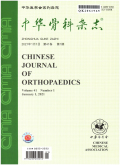后路枕骨髁螺钉置钉参数对安全性的影响
The effect of the parameters of posterior occipital condylar screws on the safety of screw placement
摘要目的 探讨国人后路枕骨髁螺钉进钉点竖直方向位置对置钉安全性的影响,分析后路枕骨髁螺钉术中以置钉安全性为目的的进钉点选择策略.方法 回顾性分析2013年9月至2015年9月60例健康成年国人上颈椎的影像资料,其中男36例,女24例;年龄25~58岁,平均(41.6±9.2)岁.排除枕颈区域损伤、肿瘤和畸形患者,利用CT扫描的Dicom数据在Mimics中进行三维数字化建模并模拟置钉,以枕骨髁后方内外侧中点为进钉点,竖直方向间隔采点,各进钉点分别以最大头倾角、最小头倾角、最长钉道、最小钉道四种状态置入直径3.5 mm虚拟螺钉,通过三维视窗评估螺钉与舌下神经管、寰枕关节等解剖结构关系,在3-Matic软件中测量螺钉头倾角、内倾角、钉道长度,计算得到头倾角安全范围、置钉成功率.结果 60例通过Mimics建模总计得到120侧枕骨髁,左右侧别的头倾角、内倾角、安全范围和长度数据差异均无统计学意义,各进钉点头倾角安全范围:下进钉点20.9°±6.0°,中进钉点17.0°±6.2°,上进钉点11.6°±7.1°,差异有统计学意义;各进钉点不同头倾角置钉成功率:下进钉点以3°和4°头倾角进钉成功率最高99.17%,中进钉点以3°头倾角进钉成功率最高96.67%,上进钉点以0°头倾角置钉成功率最高74.17%,中、下进钉点置钉成功率较上进钉点显著提高,差异有统计学意义;螺钉内倾角参数:左侧为34.41°±2.59°,右侧为34.06°±2.44°,差异无统计学意义;获得各进钉点最长钉道长度参数:上进钉点(23.09±1.47) mm、中进钉点(22.84±1.40) mm、下进钉点(23.15±1.45) mm,各进钉点最短钉道平均值约21 mm,进钉点之间差异无统计学意义.结论 后路枕骨髁螺钉进钉点的选择中,下进钉点较上方进钉点拥有更高的置钉成功率和安全性;进钉点在竖直方向上的改变对钉道长度影响较小;通过三维数字化虚拟置钉能模拟后路枕骨髁螺钉置入钉道,评估置钉安全性,减少后路枕骨髁螺钉置入风险.
更多相关知识
abstractsObjective To investigate the safety of the occipital condylar screw with vertical position and evaluate the selection strategy of the posterior approach of the posterior occipital condylar screw in Chinese people.Methods The clinical imaging data of 60 outpatients from September 2013 to September 2015 were retrospectively analyzed,36 male and 24 female,the average age was 41.6±9.2 (range from 25-58),Excluded occipitocervical injury,tumor and deformity patients.We built a three-dimensional digital model and simulated placing screw by utilizing CT data on Mimics software,after that we took the occipital condyle posterior medial and lateral midpoint as the entry point,then made 2 points equidistantly to the midpoint in vertical direction.We put 3.5 mm diameter virtual screws in 4 different conditions:largest cranial angle,smallest cranial angle,longest screw path and shortest screw path.Then we assessed the anatomical relationship between the screw and the hypoglossal canal or the atlanto-occipital joint by a three-dimensional window and measured the cranial angle,medial angle and length of screw path,then calculated the safety angle of the cranial angle,the successful rate of setting screw,and compared the safety of different screw points by 3-Matic software.Results 120 occipital condyles were obtained from the CT data of 60 patients by Mimics software.There was no significant difference in the data of the cranial angle,medial angle,safety range and length between both left and right sides.The obtained safe cranial angle of each point respectively was 20.9°±6.0° (lowest point),17.0°±6.2° (middle point),and 11.6°±7.1°(top point),obviously the largest angle was in the lower point and the smallest was in the top point.The difference was statistically significant.We then acquired the successful rates of different cranial angle of each point,the highest successful rate was 99.17%,96.67%,74.17% in lowest,middle and top point when cranial angle were 3°or 4°,3°and 0°respectively.The successful rates of lower point and niddle point were significantly higher than the top point,and the difference was statistically significant.The medial angle parameters obtained were 34.41°±2.59°on left and 34.06°±2.44°on right,and there was no significant difference.The length parameters of the longest screw path acquired were 23.09± 1.47 mm,22.84± 1.40 mm and 23.15± 1.45 mm at top,middle and lowest entry point.The average value of shortest screw path of each point was 21 mm,and there was no significant difference among every entry point.Conclusion Among the occipital condyle posterior screw entering points,selecting the lower point can improve the success rate and safety;the change of nail enter point in the vertical direction has little effect on the length of the nail.We can increase the safety and reduce the risk of occipital condylar screw placement as far as possible through the three-dimensional digital technology.
More相关知识
- 浏览180
- 被引13
- 下载128


相似文献
- 中文期刊
- 外文期刊
- 学位论文
- 会议论文



 换一批
换一批 换一批
换一批



